The 3rd Gen Intel Xeon Scalable line’s naming is a mess. In this article, we are going to have our traditional SKU List and Value Analysis piece, but this is one of two for the generation. This one is our 3rd Gen Intel Xeon Scalable Ice Lake SKU List and Value Analysis but we previously had the 3rd Gen Intel Xeon Scalable Cooper Lake SKU List and Value Analysis. Cooper Lake is a 2020-era 14nm product driven by Facebook while Ice Lake is the 2021 mainstream platform. If that sounds unreasonably confusing, it is. Still, let us get to the analysis piece.
Reading a 3rd Gen Intel Xeon Scalable Model Number
We wanted to take a moment and discuss what the model numbers mean. Specifically, we will use the Intel Xeon Platinum 8380 as our example SKU. With the 8380 we get:
- 8 – this tells us we have a “Platinum” level SKU
- 3 – 3rd Generation Intel Xeon Scalable
- 80 – The model designation
Since there is the Platinum 8380 (Ice Lake) and the Platinum 8380H/ 8380HL (Cooper Lake) you may see a H or an L at the end of a 3rd Gen SKU. These mean:
- H – Cooper Lake/ Cedar Island platform
- L – High Memory Enabled SKU for 4.5TB/ socket support
Please note, the Ice Lake processors dropped the “L” for extended memory support. There is also a “C” for “Custom” which is used in the Platinum 8321HC 88W 26C part for Facebook.
With this generation, not only do we have the “Ice Lake” designation, but Intel has made two-thirds of its SKUs from Ark special by adding additional letters at the end of the four digits.
- Y – Supports Intel Speeds Select Technology Performance Profile 2.0 (SST-PP)
- N – Networking Optimized
- P – IaaS Cloud Specialized Processor
- V – SaaS Cloud Specialized Processor
- Q – Liquid Cooling Optimized
- M – Media Processing Optimized
- T – Long-life and Thermal friendly
- S – SGX 512GB secure enclave (Some 512GB parts)
- U – Usually means single socket only or “Uni-processor” unless there is a single socket N SKU that will instead use N
A few notes here. First, M in the 1st and 2nd Gen parts denoted “Medium” memory levels. In response to AMD EPYC, we saw the 2nd Gen Intel Xeon Scalable M SKUs Discontinued, but now the letter means media processing. This was in the full table Intel sent us for launch, but the Platinum 8352M is not on Intel Ark so we are going to exclude it from our analysis. Likewise, the Platinum 8362 was in the original table but not on Ark.
As a quick update, we have a video on the current state of naming conventions:
Here is the original table from our Intel Xeon Ice Lake launch coverage:
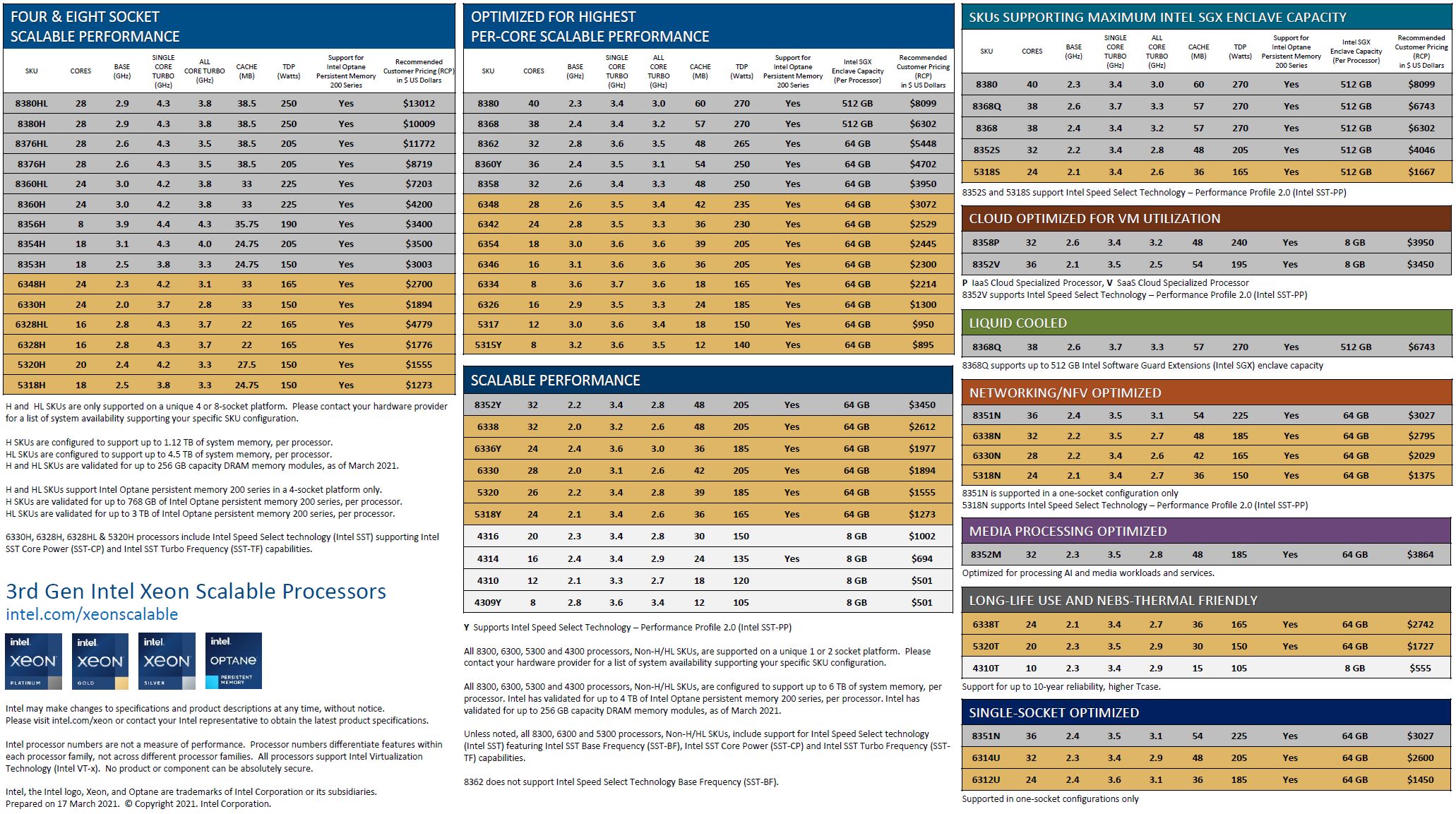
If you get into the detail of the letters above, and the table, you may get the feeling that someone at Intel gets a bonus for every new category or letter added to the naming scheme. One can liquid cool any of these processors, but there is a Q category now.
3rd Gen Intel Xeon Scalable Ice Lake Nuance
One of the big changes in this generation is that the Ice Lake series only supports up to two sockets. Whereas AMD EPYC is mostly differentiated by core counts, clock speeds, and cache, Intel goes much further than this, and the multitude of letters do not cover this even.
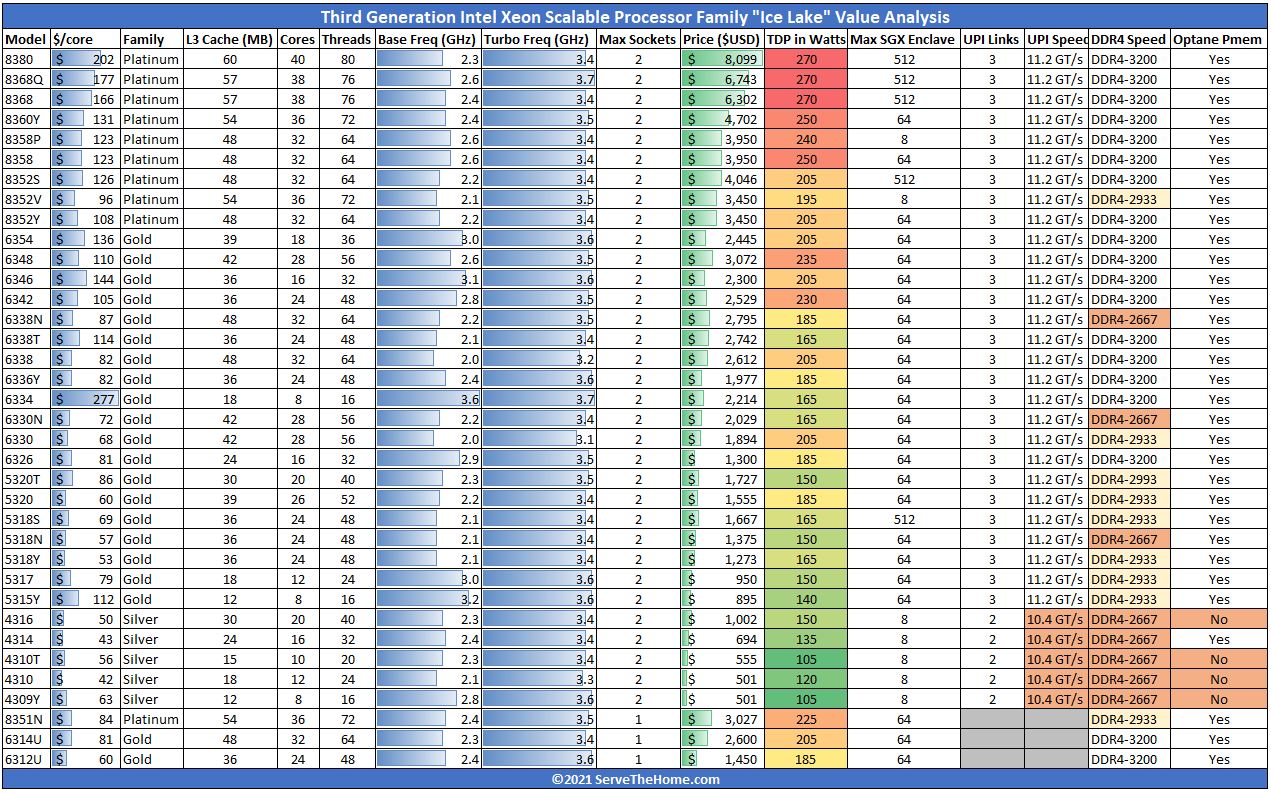
Beyond the U SKUs for a single socket, Intel has a few main points of differentiation:
- SGX Enclave Size
- UPI Links
- UPI Speed
- DDR4 Speed
- Intel Optane PMem 200 Support
As can be seen in the chart above, and largely unlike AMD, Intel varies a number of aspects of its chips to create artificial segmentation. The Xeon Silver 4316 does not support Optane PMem 200, but the Silver 4314 does, even though we only get DDR4-2666 speeds from the 2017 1st Generation Xeon Scalable era. A Xeon Platinum SKU can have maximum SGX secure enclaves of 8GB, 64GB, or 512GB.
The biggest challenge with how Intel does this, and how its competitors (AMD and Ampere on the Arm side as an example) are not, is that if one deploys an Intel Xeon Scalable Ice Lake processor, then has a new workload emerge a year later the hardware can potentially not be used. For example, if you have a workload that would require a 9GB SGX secure enclave but have a $3,950 Platinum 8358P optimized for Cloud/ IaaS, you would need to buy either new servers or go through a CPU upgrade process.
3rd Gen Intel Xeon Scalable Ice Lake SKU List and Value Analysis
Getting into our more traditional value analysis, here is what the table looks like. Again, please keep in mind we removed the two SKUs mentioned above because they were not on Intel Ark with listed MSRPs.
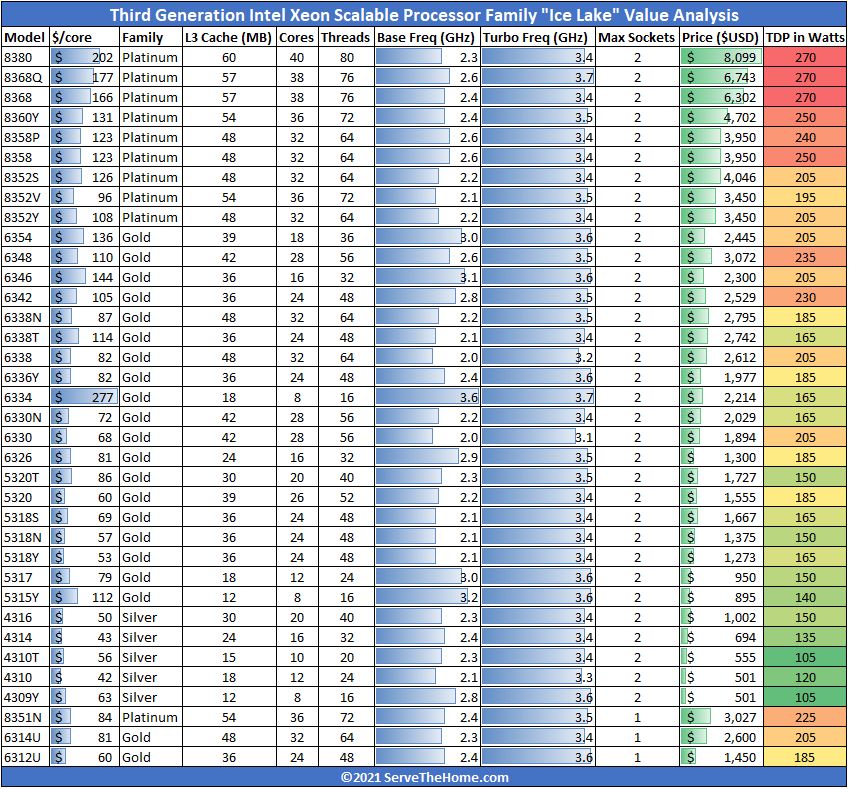
There are a few key points here. First, the cost per core seems to have fallen in this generation while the TDP has generally gone up. We also will note that the pricing do not necessarily follow the numerical order. For example, the Xeon Gold 6338 and the 6338T/ 6338N variants may seem like lower-numbered units than the Xeon Gold 6346. At the same time, we find the pricing is higher for the Gold 6338 versus the 6346. The key to remember is that a higher number does not necessarily mean a chip costs more nor does it mean that the higher numbered part has more cores.
Something else that stands out with this generation is that the clock speeds actually appear to have taken a dip. The Intel Xeon Gold 6230R was a 26 core part with a 2.1GHz base and 4.0GHz maximum turbo clock. The Xeon Gold 6330 is a 28 core part with a 2.0GHz base and a 3.1GHz maximum turbo. Where the 3.8-4.0GHz had been common, with Ice Lake frequencies are generally down but core counts are generally higher. This is important for per-core performance though. Intel will state that at the same frequency the Ice Lake core is several percent faster than the Cascade Lake core that preceded it. One must be mindful that the Ice Lake parts often run at a lower clock speed which negates that microarchitectural benefit.
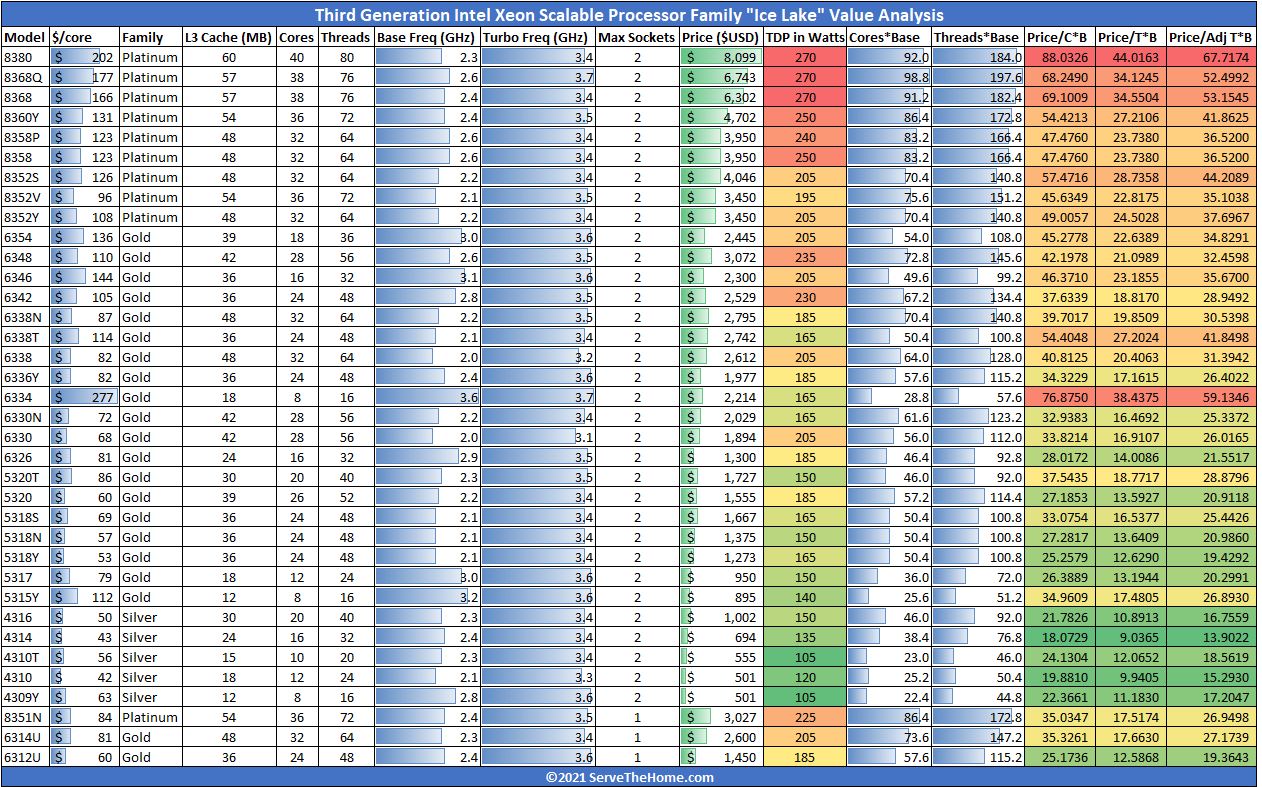
As we have seen for generations, the Xeon Silver and lower-end Gold series tend to be the best values in the lines. There are some core/ frequency optimized SKUs such as the Xeon Gold 6334 which are priced at around $277 per core because they can help to save on per-core licensing costs.
We generally look at a SMT/ Hyper-Thread as about a 30% performance addition over a non-HT core. In this generation, Intel has embraced Hyper-Threading across the board. This is likely due to increased competition which means Intel needs to bolster its thread count. If we look at the dual-socket capable SKUs, we can see that Intel actually does not have a Xeon Bronze in this series. Instead, the line starts with the Intel Xeon Silver 4310 and 4309Y.
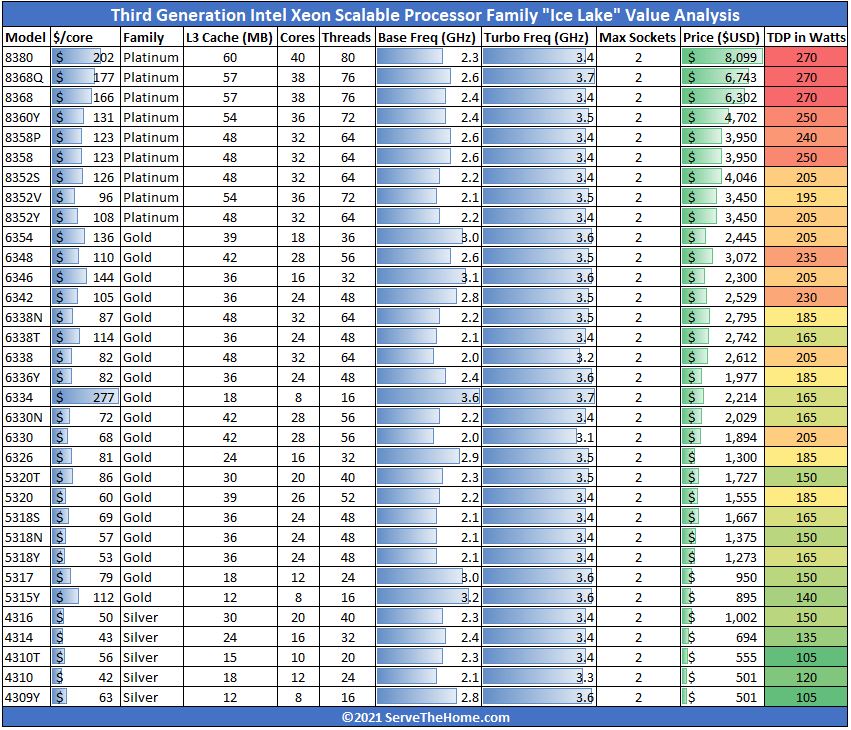
Intel also has three single-socket-only SKUs. Two of them have the “U” noted as they are uni-processor only capable parts. One SKU, in particular, is different and that is the Xeon Platinum 8351N. This N part, unlike the Xeon Gold N parts (Gold 6338N, 6330N, and 5318N) is a single-socket-only part. Also, it is listed as having only DDR4-2933 support unlike the other DDR4-3200 Xeon Platinum parts aside from the Platinum 8352V.

Although Intel does not have a single-socket 16 core part like the AMD EPYC side, Intel has a number of 16 core offerings including the Xeon Silver 4314 which gets Optane PMem 200 support, unlike the other Xeon Silvers. This part is a sub $700 part which means there is unlikely a lot of room to have a single-socket 16-core value part.
Final Words
Across a large number of markets, Intel became more competitive with its Ice Lake Xeon generation. Still, we are now at the point where we are calling chips the 3rd Generation Intel Xeon Scalable “Ice Lake” parts such as the Intel Xeon Platinum 8352V which is for virtualization but for only small SGX enclaves of 8GB or less. When it takes that many words to describe a processor, without its core count, clock speed, or cache, it is a good sign that the entire naming system needs an overhaul.
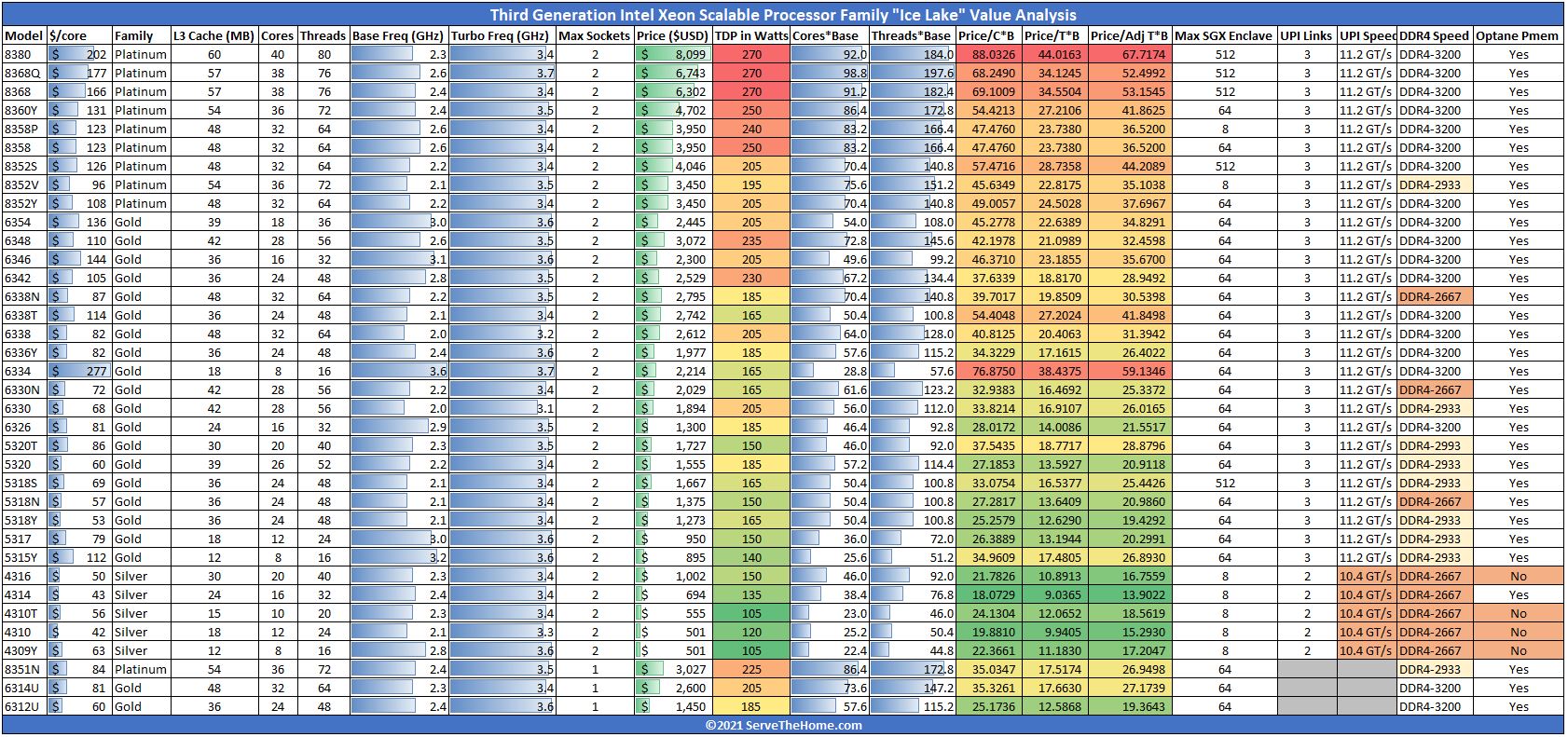
This piece was a bit later than our normal SKU list and value analysis pieces, but it is one that is perhaps even more fascinating.

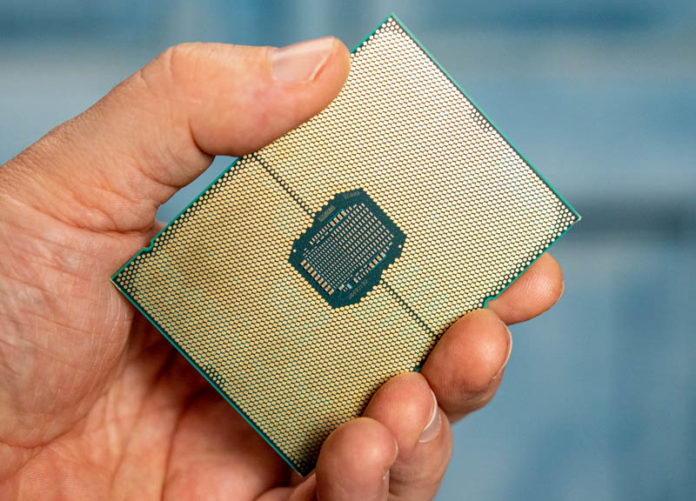



Hi Eric
Is there a chance for you to add table that are combining Ice Lakes and Cascade Lake Refresh ?
Recently I had to look on those 2 tables so many times, that I’m bit afraid of becoming cross-eyed ;-)
Ice Lake is a Hot Mess.
Noticed a typo where “Xeon” is missing a letter:
“Intel has a number of 16 core offerings including the *Xon* Silver 4314”
Intel is all-in on getting the super computer contracts: even it’s naming is a cluster!
I’m really curious what the street price + availability + performance looks like for the:
Gold 6342 VS Gold 6242R
Gold 6346 VS Gold 6246R
Especially the 6×46 since those have the same core count, with the 2nd Gen having higher base/boost frequency and listed price.
a whopping $277 per core for the 6334 8c16t part, but I suspect that this is to build in flexibility for box sellers to argue that they are discounting.
without a high memory capability, the plain 6334 in 2S looks like it will be a goto for Windows Server (sub Datacenter licensed) machines.
I have this recurring daydream that Intel should buy ScaleMP and port the ScaleMP HAL to the latest Arias and launch a virtual backplane along with PCIEgen5.
Intel was shipping Optane drives with a ScaleMP RAM HAL…
As soon as possible, my desk is (currently, front desk at trading shops can be fickle) intending to cobble together via ScaleMP the Intel dGPU AICs with a A10/14 VM partition, served by a clustered machine, most likely heavy with PMem Optane for running in-PMem LOB applications (in late-ish alpha with DAOS) and have the reputedly video codec strong Xe architecture offloading the ballooning 24/7 video calls that are replacing the squawk box.
Interesting time to inherit FOH platform responsibilities…
I meant to say that I am expecting yet another suffix descriptor to signify integrated graphics, if Xe works well. I know enough people running suitably light video analysis such as OCR ing subtitles from news monitor feeds, to care for one high end integrated part. Personally, I think it would fetch quite a premium for who can use it.
if it sounds a little wild to create a single image cluster and run core applications on a member instead of your desktop head, it’s to accommodate fault tolerant implementations for order compilation / dispatch
Help! I have a pair of 8269CY Platinums, what do the letter means!!? :)